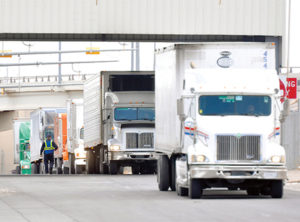by Dan Middleton and Swapnil Samant
The same innovation that could let your car talk to others in the near future could also reduce the time you wait for your new television or fresh produce by making truck safety inspections at the U.S.-Mexico border quicker and more thorough.
At the Center for International Intelligent Transportation Research (CIITR), a part of the Texas A&M Transportation Institute (TTI), we’re finding ways to facilitate those inspections through an alternate application of connected vehicle (CV) technology.
America imports more than $270 billion in goods per year from Mexico. Not only TVs, fruits and vegetables, but also medical and surgical instruments, beverages, and even cars. The trucks transporting those products must be inspected to ensure they don’t pose a safety hazard to travelers and shippers on U.S. highways.
Currently, officials with the Federal Motor Carrier Safety Administration (FMCSA) and the Texas Department of Public Safety (DPS) choose trucks randomly to visually check things like tire and brake conditions. Any violations detected must be corrected before a truck can proceed northward.
This approach sometimes includes unnecessary redundancy when, for example, agencies perform duplicate inspections, possibly on the same vehicles. Because trucks are selected randomly, this approach could allow unsafe vehicles to pass through uninspected while time is spent inspecting safe vehicles more than once.
Here’s where advanced technology can make some inspections more efficient and more comprehensive. Passenger vehicles will soon use CV technology—specifically, dedicated short range communication (DSRC)—to transmit safety messages to detect blind spots, red-light runners, and other safety hazards, enabling self-driving safeguards like automatic braking. Those signals are transmitted as fast as 10 times per second between the electronic on-board units (OBUs) in vehicles.

Applying connected vehicle technology can facilitate movement of goods by semi-truck, making it possible to inspect more trucks in less time at border check points.
Semi-trucks will have similar uses for technology while being driven to deliver a load of goods but also while undergoing a roadside safety inspection. Most trucks today are required to have an onboard device to electronically track driver hours-of-service in real time, which is an operator component of a typical roadside inspection. Besides hours of service, items that should be available to inspectors include a Medical Examiner’s Certificate, vehicle registration, and operating authority. Through our research, we’re investigating ways to monitor this information quickly and wirelessly while the vehicle is stopped (or, perhaps, while the truck is in motion), making it possible to inspect more trucks in less time.
Ideally, FMCSA and DPS officers could see this information, along with license plate numbers, displayed on a tablet before a truck even reaches a border crossing. Eventually, we could even develop a database of vehicles and drivers, assigning a score for each motor carrier. That could not only improve safety, but would also facilitate cross-border goods movement. More efficiency and faster goods movement saves shipping costs for companies, and that can save consumers money when they shop.
The inventors of Play-Doh thought they had an idea for wallpaper cleaner, not for a malleable children’s toy. The makers of Dawn dishwashing detergent probably didn’t anticipate the product being used to clean crude oil from pelicans after a spill. And engineers who were laying the groundwork for autonomous travel more than 20 years ago might never have imagined that AV technology could make truck inspections faster at international border crossings.
But if our work proceeds as planned, that’s exactly what should happen.
Dan Middleton is a Research Engineer in TTI’s Advanced Transportation Operations Program. Swapnil Samant is a Software Applications Developer with TTI’s Center for International Intelligent Transportation Research.



